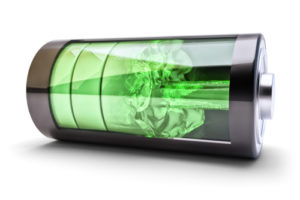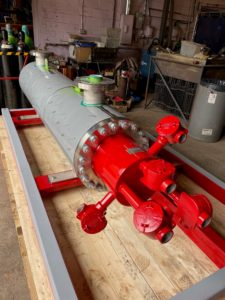Flow Batteries and their Role in Process Heating
Last updated on May 13th, 2025 at 04:15 am
Ice, glass, and iron are revolutionizing the way scientists think about the long-standing problem of energy storage. This is the story of flow batteries, newly emerging as a prominent stand-alone energy storage solution.
For a long time, renewable energy sources like solar and wind have been plagued with unreliability in terms of reliable power supply. Unreliability meant we had to resort to coal or gas-powered power plants for our energy needs. 
One of the solutions explored to deal with the intermittent power supply is having an energy storage means tied to renewable energy sources. This means it stores the energy at peak production periods and discharges it when the supply falls short of demand.
More traditional battery solutions, including Li-ion batteries, have proved to be expensive, dangerous, flammable, and hampered by the issues of storage degradation once the charging and discharging cycle starts increasing.
Flow batteries solve the challenges associated with traditional energy storage mediums. A new technology, flow batteries use electrolytes are stored separately in tanks. They are pumped through an electrolytic cell where compartments are separated by a membrane which allows only the exchange of ions.
The flow battery is also called a Redox battery because it encompasses reduction/oxidation on both sides of the membrane. Unlike traditional batteries, like Lead-acid batteries, where the electroactive material is stored in the electrodes, flow batteries store energy in the electrolyte itself.
Types of flow batteries
There are many types of flow batteries varying in energy density and cost, with the biggest differentiator being the electrolyte itself. There are around 10-12 different chemistries for industrial applications deemed applicable.
All flow batteries operate in the same way. The negative electrolyte (catholyte) and positive electrolyte (anolyte) are stored in a separate tank. They are pumped to the electrodes to exchange ions through the ion-exchange membrane. The power produced is a function of the surface area of the electrode, while the energy storage depends on the volume of electrolytes. Some common types of flow battery chemistries include:
- Ferrous Chloride solution
- Bromine-polysulfide
- Vanadium-vanadium
- Vanadium-bromine
- Zinc-bromine
- Zinc-cerium.
Like other batteries, you can stack flow batteries in series to deliver the required voltage potential.
Another recent advent is hybrid flow batteries. Electroactive material is deposited on the electrode during the charging cycle and dissolves back into the electrolyte during the discharging cycle.
Use Cases of flow batteries
Flow batteries are configured according to the power requirements and the application. Applications related to utility power storage would need millions of gallons of electrolyte storage connected with pipes to the stacked modules with field erected tanks. Commercial applications would need a modular packaged solution that can fit into a typical utility room for a behind-the-meter commercial system to containerized package for a 1 MW to 10 MW application.
One downside of flow batteries compared to the less maintenance-intensive Li-ion batteries is that the power stacks, pumps, seals, and control instrumentation require routine and preventive maintenance. This increases maintenance cost and operational expenditure with these flow batteries. However, a rigorous preventive maintenance plan keeps these operational maintenance costs low. Let’s investigate some of the use cases of the flow batteries where their worth is proven compared to Li-Ion batteries.
Process Heating
Process heating with immersion heaters is one of the important applications of flow batteries. Compared to the Lithium-ion battery, which is designed for a deep discharge, encounters greater degradation with the increase in charging and discharging cycles. The max available power storage is less than 6 hrs. 
Process heaters, whether for power plants or petrochemical facilities, require reliable energy sources to power the immersion heaters. Traditionally, that power comes from grid or gas/diesel power generators, which contribute to greenhouse gas emissions.
However, in recent years every entity and company is trying to incorporate ESG targets in their objectives. Flow batteries have emerged as a strong candidate to provide energy for process heating applications. These batteries are scaled up to a commercial scale stacked package to provide high current commonly demanded in process heating.
Safety is a major advantage of flow batteries. They use no flammable, toxic, or explosive chemicals, especially in the case of iron flow batteries. They can be scaled up for higher energy storage by virtue of chemical electrolytes stored outside in the tanks.
The power control module and cell characteristics like electrode area do not need to be changed or modified to enhance capacity. It will remain the same if the voltage required is the same. This has an important advantage for process heating which may need brownfield expansion in the future. An intrinsically safe system is a requirement most of the time.
Arbitrage
A classic application of flow batteries in the power market is when peak demand puts a lot of load on the existing grid supply structure. This, coupled with the environmental factors, results in a spike in power costs. The flow batteries can easily help load balancing, thus taking the strain away from existing power generation capability.
Behind the meter
One of the commercial-scale applications of containerized modular stack flow batteries is in behind-the-meter applications.
- Hospitals
- Residential Campuses
- Manufacturing Facilities
They can significantly shave off costs during the peak demand periods when unit rates per kWh of electricity are being charged. In cases where voluntary or involuntary curtailment occurs from national grid providers, these flow batteries can provide much-needed power.
Conclusion
Li-ion batteries currently dominate the energy storage market. But due to shorter charge storage, customers, especially renewable energy providers, are looking at long-term energy storage systems. The costs of flow and Li-ion batteries are decreasing due to economies of scale and manufacturing efficiencies associated with the production. With the current Li-ion battery technology, the cost ($/kWh) is constant beyond the 4-hour mark because of the need to add more batteries. But with flow batteries, when the storage increases beyond 6 to 8 hours, the unit cost decreases. Making them an ideal candidate as a long-term energy storage asset.
